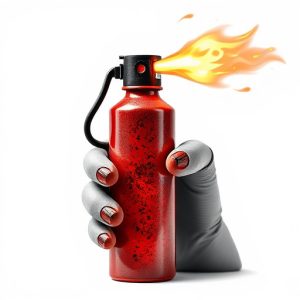Decoding Pepper Spray Safety and Flammability: A Comprehensive Analysis
Pepper spray, a common self-defense tool, is not inherently flammable under normal conditions, desp…….
Pepper spray, a common self-defense tool, is not inherently flammable under normal conditions, despite containing compounds that can be ignited under extreme heat or direct exposure to fire. While it is chemically stable and non-flammable on its own, care must be taken to prevent contact with high temperatures or open flames due to the volatile substances within the spray's propellant. Regulatory bodies like the EPA have established guidelines to ensure safety by dictating the chemical composition and proper storage of pepper spray. Users are advised to follow these guidelines strictly to avoid any fire hazards and to handle the spray responsibly, recognizing its potential reactivity with heat sources. It is important to understand that while pepper spray is not flammable in the traditional sense, it is crucial to adhere to safety standards to maintain its effectiveness as a non-lethal self-defense tool and to prevent any dangerous outcomes when used in environments with elevated fire risks. Compliance with these measures is essential for both legal and personal safety considerations.
Exploring the multifaceted nature of chemical sprays, particularly pepper spray, this article delves into its composition and function, while also addressing critical safety considerations. We will investigate the flammability factor of pepper spray, dispelling myths around its combustibility with factual insights backed by chemical analysis. Furthermore, the article examines how safety standards across regulatory bodies are designed to ensure proper use in various scenarios, providing a comprehensive overview of this self-defense tool. Keywords: Understanding Pepper Spray, Flammability Factor, Chemical Analysis, Regulatory Perspectives, Is Pepper Spray Flammable.
Understanding Pepper Spray: Composition, Functionality, and Safety Considerations
The Flammability Factor: Is Pepper Spray Combustible?
When assessing the safety and efficacy of chemical sprays such as pepper spray, understanding their reactivity with heat sources is paramount. Concerns about the flammability of pepper spray arise due to its composition, which includes capsaicin and other irritant compounds suspended in a liquid solvent. While the primary function of pepper spray is to incapacitate by causing intense pain and disorientation upon contact with mucous membranes, questions regarding its combustibility are crucial for safe handling and storage.
Despite initial apprehensions that the volatile components in pepper spray might make it flammable, scientific testing has shown that under normal conditions, pepper spray is not easily ignitable. The solvents used in formulating pepper sprays have low flash points, which might suggest combustibility; however, the presence of other ingredients serves to suppress flammability. In practice, direct application of an open flame to pepper spray can cause it to ignite, but this is not indicative of its inherent combustibility when used as intended. It is essential for users to store and carry pepper spray according to manufacturer guidelines to prevent any unintended and potentially dangerous reactions with heat sources or open flames. Understanding the flammability factor of pepper spray is essential for personal safety, especially in environments where fire hazards are a concern.
Chemical Analysis: What Makes Pepper Spray Tick and Its Reactivity with Heat Sources
Pepper spray, a form of non-lethal self-defense, is a lachrymatory agent designed to incapacitate an assailant by causing irritation to the eyes, skin, and respiratory system. Its primary active ingredient is oleoresin capsaicin, derived from chili peppers. The chemical composition of pepper spray includes various capsaicinoids, which are responsible for its intense pungency and its effectiveness as a deterrent. The concentration of these capsaicinoids can vary, influencing the level of incapacitation and duration of effect.
When considering the reactivity of pepper spray with heat sources, it’s important to understand that while the solution itself is not flammable in the traditional sense, exposure to high temperatures can alter its chemical properties. Heat can cause the breakdown of capsaicinoids, potentially reducing the spray’s efficacy. Conversely, the application of pepper spray in a hot environment or near a heat source can increase its reactivity and potency, leading to faster onset and more intense effects. The interaction between capsaicin and heat is complex; while direct flame contact is unlikely to ignite the spray, the chemical can volatilize at high temperatures, which may affect its dispersion and burning sensation upon contact with mucous membranes. It’s crucial for users to be aware that environmental factors such as temperature can influence the performance of pepper spray, necessitating careful consideration during its deployment in various conditions. Understanding these dynamics is essential for ensuring safety and effectiveness when utilizing this self-defense tool.
Regulatory Perspectives: How Safety Standards Address the Use of Pepper Spray in Various Scenarios
Chemical sprays, such as pepper spray, are subject to rigorous safety standards that govern their use in various scenarios. These regulations are critical in ensuring the appropriate and safe application of pepper spray, which is a non-lethal self-defense tool commonly used by law enforcement officers and civilians alike. The safety standards address the potential risks associated with its deployment, including its flammability. While pepper spray itself is not inherently flammable, the presence of an ignition source near the chemical’s propellant can create a risk of fire. Regulatory bodies, such as the Environmental Protection Agency (EPA) in the United States, have established guidelines to mitigate this risk. These include specifications on the composition of the spray and its container, ensuring that it is formulated to minimize the chance of combustion when used in close proximity to heat or open flames. The standards also mandate proper storage conditions to prevent the exposure of pepper spray to extreme temperatures, which could otherwise compromise its safety. In scenarios ranging from personal defense to crowd management, these safety standards are paramount to protect both the user and bystanders from potential harm. Compliance with such regulations is not only a legal requirement but also a moral obligation to ensure that pepper spray is used responsibly and effectively within the bounds of its intended purpose.

